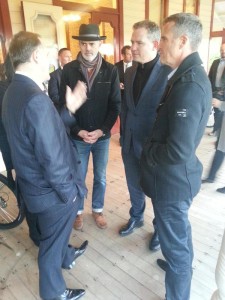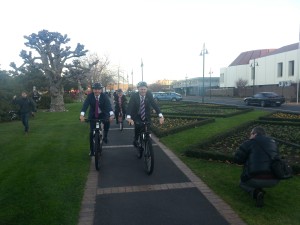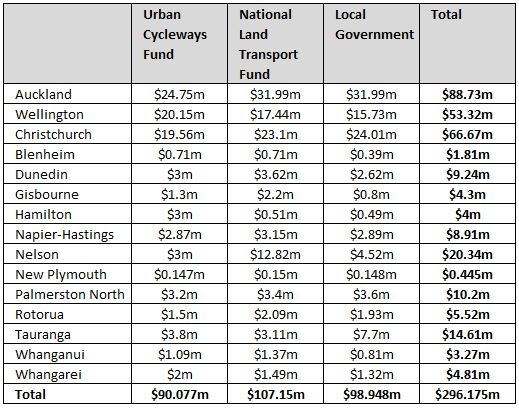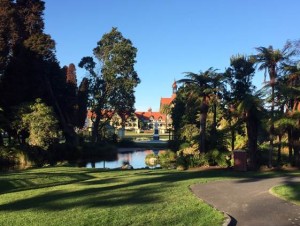
We sent Bruce Copeland on a road trip to Rotorua last Thursday to represent Cycle Action at the announcement of the second tranche of funding for the Urban Cycleways Fund (UCF). Here’s his report on what it all means for biking in Auckland:
Last Thursday had the feel of watching history in the making: at long last some serious cash is being invested in proper cycling infrastructure. (A fiscally prudent motorist may say this is a crazy lolly scramble, but it’s small lollies compared to the big bickies spent on tarmac). Whatever your viewpoint, how has Auckland fared?
Have we got our fair share, and is it being spent in the right places?
The UCF is a $100m fund designed to unlock funds that NZTA wants to spend on cycling. Historically, it hasn’t been spent because Councils can’t or won’t allocate funds to cycling that would unlock it. With the Government stumping up money, Councils understood this was an ideal opportunity to get highly subsidised infrastructure.
Like their rugby teams, the other urban areas put up a fierce fight. Luckily for Auckland this time round, secondary urban areas (for example Whakatane, Taupo, Queenstown) weren’t included, or else the competition would have been even more formidable.
There was no standard formula: rather, the Government Investment Strategy set out criteria including Primary Corridors, leverage, benefit / cost ratios and, worryingly for Auckland, timeframes. If a project needed to draw on the National Land Transport Fund, it would also need to meet the Investment Assessment Framework. NZTA had a massive job in assessing and prioritising and testing this against the views of the Investment Panel.
All up, this was a subjective process, and I suspect all the proposals were very worthy and some difficult decisions and horse trading went on. Particularly difficult for Auckland was trying to get commitments from Auckland Council and Auckland Transport to stump up their share at the same time they were going through Long-Term Planning and Annual Budgets. This is a “use it or lose it” situation, and Auckland can still lose it if Auckland Transport can’t get projects over the line because of budget, consents or delivery. Fortunately the Auckland Council approved its Interim Transport Plan on the same day, unlocking its own enhanced contribution.
Previously, the Panel had handed out $10m. Last week they handed out the remaining $90m. Here’s where it went:
The cynics out there commented that Tauranga has a relatively generous spend of $14.61m, but it should also be noted that the local Council is stumping up a meaty $7.7m. Nelson, on the other hand, has an even more impressive $20.34m, but they arm-twisted NZTA into picking up 63% of the bill, the local Council only $4.52m. Nelson has the highest percentage of people walking and cycling at 18% (2013 Census) and their key project is the Nelson Coastal Route, which is alongside a very busy State Highway. This probably explains why NZTA funded such a high amount – as in Auckland, state highway cycle projects tend to be 100% NZTA funded.
Interestingly for Local Body amalgamation, Wellington is described as “Wellington Region” and they have projects neatly divided into Kapiti, Wellington City, CBD, Eastern, Lower Hutt, Upper Hutt and Porirua. By comparison, Auckland (which as we know is amalgamated) just has projects for Auckland Central, divided into City Centre, Eastern and Western connections and, for our friends at Transport Blog, links to Public Transport. Obviously the focus is firmly on Central Auckland, and in contrast to Wellington, the outer suburbs have – well, there is no nice way of saying this – missed out for now. Ouch.
The problem as I see it: the criteria wasn’t to “spray the money thinly and evenly around the whole region and try and keep everyone happy.” Also, as some of the bitterest critics point out, Auckland currently only has a smattering of disconnected and inconsistent infrastructure, which is rather sad and embarrassing. I don’t think we were going to fare well by saying we were going to continue with this bitsy plan. Obviously Auckland has to get more strategic about where to invest, and this was the major focus of AT and the Panel.
The City Centre Network focuses on an area where there is the greatest opportunity for increasing the numbers of people cycling: a cycleable distance between 5 to 7 km of the City Centre. Delivery will start with the “easier” routes within that area, where there is already support for cycleways such as Karangahape Road, Great North Road, Herne Bay etc. That will build a foundation that will create the justification to take on the more contentious roads, maybe Ponsonby Road, Symonds Street etc.
At the same time 4.7km of local cycleways will be built in a 1 to 3 km radius around the New Lynn and Glen Innes town centres, to provide connections to rail and public transport. This is a good combo, as public transport will boom even more when people can reach it more easily and safely on bikes. (Smart spending compared with buying land for big park and rides and once this is realised, plans can be evolved, changes made and further roll-outs planned.)
Then there are the Western and Eastern Routes. The Western Route probably isn’t contentious. A whopping 14.6km of separated cycleways completing connections from Western Suburbs to the City Centre, but also making important connections to workplaces, schools, Unitec, shops and cafes. This seems both strategic, in terms of having proper and significant cycleways that will encourage uptake from commuters and recreational cyclists, while also aiming to ignite local riding in these areas. Again, once you build it, they will come, which will prove the need to roll this model out further across the city.
The Eastern Connections might seem more of a mystery. A significant part of this initiative, the GI to Tamaki route, utilises land owned by NZTA that was originally purchased for the Eastern Arterial Motorway. With the motorway finally being put to death, there was a risk that this route would be lost to the public. I think it’s a stroke of brilliance that this beautiful corridor of green can be grabbed for the public of Auckland to walk and ride. Arguably, it’s more of a “greenway” project, but it’s squarely within a dense urban environment and I think this will be a stunning ride. I’m not sure whether I will take this route on my road bike to complete a loop back along the waterfront – but I’m not worried, as it’s great to have choices, and I can see families using this during the weekends, and commuters utilising it during the week. It also opens up very interesting potential for local residents to get to schools, shops, friends more quickly than taking the long way around the road in the car.
So we have:
- A package of cycleways around the Central City where there is the greatest opportunity to get numbers
- We kick off the Cycling / Public Transport link while increasing local cycling opportunities in New Lynn and Glen Innes
- We get the Western Routes finished properly with local cycling and a big uplift in commuters and recreational riders linking up to the City, and linking the City to the West, of course
- Then we have the Eastern Routes, including a stunning new ride, much of it in a “greenway” style environment
Sadly, there is a huge list of areas in Auckland that will not be directly affected by this $100m of projects. But I’m sure every corner of Auckland will be indirectly affected by the halo effect it creates.
Auckland cycling infrastructure has been woefully neglected – remember, it was only in February of this year we were hearing that AT was planning to spend a total of $5m over the next three years. Which was chump change, the rounding error on their IT budget. Frankly, it was insulting and a joke. Against that backdrop, we have witnessed a stunning and significant turnaround in cycling’s fortunes.
Cycling advocates, quite understandably, can be an opinionated and feisty bunch. Right or wrong, decisions have been made for the next few years. It’s time to get behind cycling in Auckland, and to continue our work, and to work with AT, AC and NZTA to give people a chance to get out there on their bikes. We know they want to! And the more people that cycle, the more money that cycling will get.
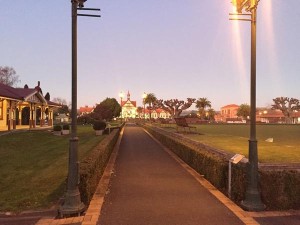
This is the “end of the beginning, not the beginning of the end”, said Geoff Dangerfield, the CEO of NZTA, at the launch. The Urban Cycleway Investment Panel Tenure ends in June 2015: that is the end of the beginning. We also have the Skypath decision to look forward to – let’s hope our stunning run of good fortune continues! Whatever the decision, this is the 3-year start of what is probably a ten year program.
I feel a real enthusiasm and commitment to cycling from Government, AT, AC and NZTA, and so there is no need to feel that nothing will ever happen in your area (especially given that the UCF money doesn’t cover anywhere like all projects related to cycling in Auckland). You can help expand our good fortune and this energising boost in funding by getting behind and supporting AT, getting involved in your local community, coming on board with Cycle Action – and most important of all, riding your bike and encouraging others too.
– Bruce Copeland
